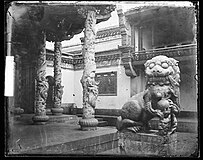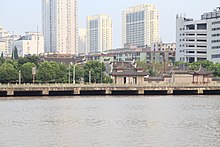
Ningbo is a sub-provincial city in northeast Zhejiang province, People's Republic of China. It comprises six urban districts, two satellite county-level cities, and two rural counties, including several islands in Hangzhou Bay and the East China Sea. Ningbo is the southern economic center of the Yangtze Delta megalopolis. The port of Ningbo–Zhoushan, spread across several locations, is the world's busiest port by cargo tonnage and world's third-busiest container port since 2010.
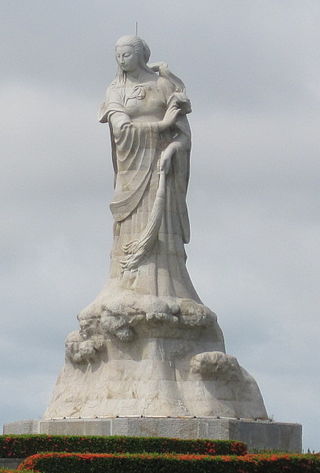
Mazu or Matsu is a Chinese sea goddess in Chinese folk religion, Chinese Buddhism, Confucianism, and Taoism. She is also known by several other names and titles. Mazu is the deified form of Lin Moniang, a shamaness from Fujian who is said to have lived in the late 10th century. After her death, she became revered as a tutelary deity of Chinese seafarers, including fishermen and sailors. Her worship spread throughout China's coastal regions and overseas Chinese communities throughout Southeast Asia, where some Mazuist temples are affiliated with famous Taiwanese temples. Mazu was traditionally thought to roam the seas, protecting her believers through miraculous interventions. She is now generally regarded by her believers as a powerful and benevolent Queen of Heaven.
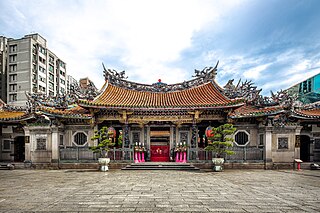
Bangka Lungshan Temple is a Chinese folk religious temple in Wanhua District, Taipei, Taiwan. The temple was built in Taipei in 1738 by settlers from Fujian during Qing rule in honor of Guanyin. It served as a place of worship and a gathering place for the Chinese settlers. In addition to its Buddhist elements, it includes halls and altars to Chinese deities such as Mazu and Guan Yu.
Lugang or Lukang may refer to:

Yinzhou is a district of the major city of Ningbo, Zhejiang province, China.

Quan Am Temple is a Chinese-style Buddhist temple located on Lao Tu Street in Cho Lon, District 5, Ho Chi Minh City, Vietnam. Founded in the 19th century, it is dedicated to Guanyin, the Chinese goddess of mercy and the Chinese form of the Indian bodhisattva Avalokiteshvara. The pagoda is popular among both Vietnamese and Chinese Buddhists; most of its inscriptions are in Chinese characters, but some have had Vietnamese labels added. In addition to veneration of Guanyin and the teachings of the Buddha, the pagoda also includes Pure Land worship of the Amitabha Buddha, elements of Taoism, and the folk worship of the Fujianese sea goddess Mazu in her role as the "Queen of Heaven".

The Thien Hau Temple, officially the Tue Thanh Guildhall, is a Chinese-style temple of the Chinese Goddess of Sea, Mazu on Nguyễn Trãi Street in the Cholon ("Chinatown") of District 5 in Ho Chi Minh City, Vietnam.

Guwenhua Jie, Tianjin's Ancient Culture Street, is a pedestrian pathway complex dotted with temple gates and kiosks on the west bank of the Hai River in Tianjin, China. The Nankai District area is classified as a AAAAA scenic area by the China National Tourism Administration.

Zhaobao Mountain also known as Zhaobao Mount or Zhaobao Hill. Located on the north bank near the mouth of the Yong River at the east end of the town of Zhenhai 12 miles (19 km) northeast of the city of Ningbo.
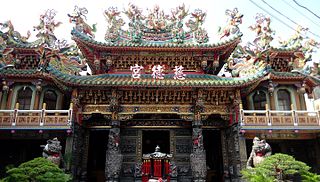
The Cide Temple on Dianziding Street, also known as the Dianziding, Liujia, Mazu, or Tianhou Temple, is a temple northwest of Lotus Lake in Zuoying District, Kaohsiung, Taiwan. In Chinese, it is commonly distinguished by its location.
The Luerhmen History and Culture Museum is a historical and cultural complex in Annan District, Tainan, Taiwan.

The Tianfei Palace, officially the Mazu Cultural Palace and also known as the Tianhou Palace, is a restored temple of the Chinese sea-goddess Mazu, the deified form of the medieval Fujianese shamaness Lin Moniang, located in Fangta Park in Songjiang, Shanghai, in eastern China. Officially classified as a museum, the Tianfei Palace conducts Mazuist rites twice a year, on the traditional anniversaries of Lin Moniang's birth and death. It is also used as the site for an annual commemoration of Songjiang's city god Li Daiwen.
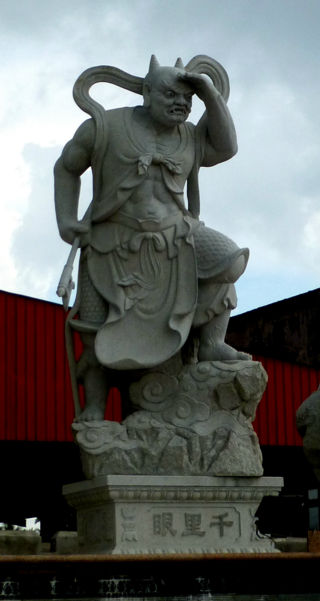
Qianliyan is a Chinese sea and door god. He usually appears with Shunfeng'er as a guardian of the temples of the sea goddess Mazu.
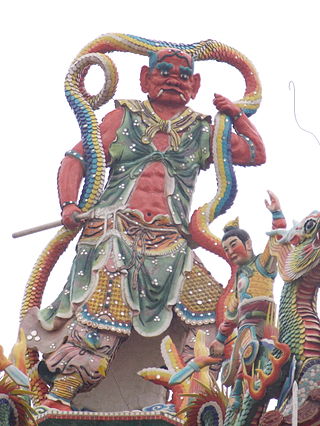
Shunfeng'er is a Chinese sea and door god. He usually appears with Qianliyan as a guardian of the temples of the sea goddess Mazu.

The Lukang Tianhou Temple, also known as the Lukang Mazu Temple, is a Chinese temple dedicated to the Chinese Goddess Mazu, the Goddess of Sea and Patron Deity of fishermen, sailors and any occupations related to sea/ocean. The temple is located at 430 Zhongshan Road in Lukang Township, Changhua County, Taiwan. It is one of the island's most famous and popular Mazu temples.

The Penghu Tianhou Temple is a temple dedicated to the sea goddess Mazu located on Zhengyi Street in Magong City, Penghu, Taiwan. It is usually considered the oldest Mazu temple in Taiwan and, despite differences in characters, is the namesake of the surrounding city of Magong. It is open from 7:00 am to 5:30 pm daily.
Yu Zigao was a Chinese admiral. He was responsible for forcing the Dutch to leave Penghu Island. While he enriched himself by way of an association with one notorious pirate, Li Dan, his position came under pressure because of another pirate, Li Dan's protégé, Zheng Zhilong.










